

One of the joys of running the "30 Years On" Web site has come from the opportunities it has created to explore the origins and context of "2001: A Space Odyssey". The film alone inspires and enthralls us, yet how fascinating it is to follow the concept back to its source, and onwards through all the sequels.
"From Pulp to Love and Death - Arthur C. Clarke's Odyssey" is your guide to a saga that spans almost half a century, from the first publication of Arthur C. Clarke's short story, "Sentinel of Eternity" in Spring of 1951 in the science- fiction compendium "10 Story Fantasy", through his reworking of the concept during those heady days with Stanley Kubrick in "The Lost Worlds of 2001", all the way to "3001: The Final Odyssey".
"From Pulp to Love and Death - Arthur C. Clarke's Odyssey" has a companion page in Underman's "The Odyssey through Other Eyes", which shows many of the books and other items that have been produced about the 2001 phenomenon.
|
|
Click here to obtain copies of Arthur C. Clarke's books |
 |
"Before there were men on Earth, that signal- sending pyramid had stood alone on a lifeless moon. What would
happen now that its alarm was silenced?" In 1968, we all discovered just what did happen.
Copyright 1951 by Avon Periodicals, Inc. |
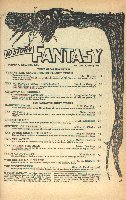 |
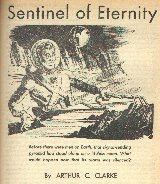 |
The story that would ultimately lead Clarke and Kubrick to create "2001: A Space Odyssey" appears fourth in
the list of "Ten Fantastic Short Stories" which comprised Vol 1, No 1 of "10 Story Fantasy". This uncredited drawing may well be the first graphic image ever to illustrate Clarke's words, and can perhaps be considered a direct if distant ancestor of Stanley Kubrick's work. The "Three Great Novelettes" that preceded the short stories seem to have been something of a bonus, but there is something about the whole concept of pulp science- fiction that makes you yearn for a time machine of your own... | |
| "Three Great Novelettes" | |
|
Tyrant and Slave-Girl on Planet Venus" (science-fiction) by John
Beynon Bert had to take his choice of the decadence of Old Mars or the harsh virility of the New Venus. | |
|
"The Poisonous Soul" (weird-fantasy) by Franklin Gregory Was that stranger merely a man who looked like a snake - or was he actually a snake that looked like a man? | |
|
"Getaway on Krishna" (interplanetary adventure) by L. Sprague de
Camp There was a secret to winning that mad race over the ice of that far planet - a secret only one Earthman knew. | |
| "Ten Fantastic Short Stories" | |||
|
Haunted Atoms by A.E. Van Vogt Five hundred years after Hiroshima, will new spectres walk among the graves? |
Cry Witch! by Fritz Leiber What was it about that young lady that made the villagers bar their doors at night? | ||
|
Friend to Man by C.M. Kornbluth Martian charity demanded payment in its own eerie way! |
Sentinel of Eternity by Arthur C. Clarke What would happen when the signal pyramid on Luna was silenced? | ||
|
The Other Side of the Wall by August Derleth Pineus Hawk couldn't understand why that unfinished wall whispered to him. |
Private World by Martin Pearson Mr. Allen found himself being shot at in a war he couldn't believe in! | ||
|
Uneasy Lies the Head by Lester Del Rey Civilization would fail if no one could be found strong enough to replace the dying mastermind. |
Seeds of Futurity by Kris Neville Edward Barnett had a scheme to solve an old world's strange dilemma. | ||
|
Who Builds Maos Traps? by K.W. Bennett Some fiend left a "better mouse trap" at the city editor's desk. | The
Woodworker by Gene A. Davidson Something was carving stinging insects out of wood - and bringing them to life! | ||
![]()
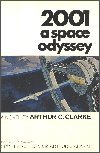
|
On your left, the dust jacket to the first U.S. printing of "2001: A Space Odyssey", published in 1968 by
the New American Library, featured (front) Robert McCall's widely- reproduced painting of the Orion
spacecraft
leaving the space station (the inappropriate "jet trail" is a giveaway! Kubrick only shows us the Orion on its
approach to the station) and (back) a still of Dave's face from the movie. Try buying this now for the original
cover price of $4.95. On your right, how the book first appeared in the U.K., courtesy of publishers Hutchinson & Co. Dave's face makes it on the front cover, while the Orion spacecraft looms out of the gloom on the back. A bargain, at 25s (£1.25 - look it up in your history book). Copyright 1968 by Arthur C. Clarke and Polaris Productions, Inc. Published by the New American Library, Inc., New York and Hutchinson & Co., London |
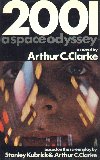
|
|
The following information applies to the U.S. edition. The text on the back reads:
One of the most dazzling imaginative feats in film history, Stanley Kubrick's production took 4 years to make. It is the odyssey of the spacecraft Discovery, hurtling its human voyagers through a fantastic passage of stars towards a confrontation with an unknown Intelligence. Life magazine calls it "a movie that dazzles the eyes and gnaws at the mind." Produced and directed by Stanley Kubrick for MGM, 2001: A Space Odyssey is now showing in the major cities of the world in Cinerama. The flaps of the dustjacket contain the following. A breakthrough into the twenty-first century, this novel puts the man of today into the credible environment of tomorrow, when he has conquered the perils of interplanetary travel and is ready for what comes next. You are hurtling across the abyss of space on an expedition to unexplored planets. Your only companion is a fellow astronaut: the three hibernauts who lie in a deep- freeze sleep will not be awakened until their skills are needed. An essential member of your crew is Hal, the electronic, almost- human brain that ceaselessly guides your course. For months your atom- powered craft Discovery has been carrying you away from earth at a hundred thousand miles an hour. You are now farther from home than any man in history. Your living quarters within the 400- foot- long spacecraft is a centrifugal drum equipped with an electronic library of literature and music. Here you relax, eat, exercise, sleep, and chat with Hal, the conversational computer who never forgets anything - not even your birthday. Your mission is of such importance that it has been surrounded by the deepest official secrecy. You are probing a fantastic frontier, following a trail that has led to the outer edges of the Solar System. You are searching the stars for evidence that Man is not alone. On the Earth- colonized Moon, deep in the crater Tycho, a discovery has been made that has shattered the human concept of the universe. You are journeying toward something. You do not know what it is. You only know that it has been waiting for Man to find it for three million years. Arthur C. Clarke, Fellow of the Royal Astronomical Society and a distinguished writer of science fiction, has produced a work that compares to the prophetic novels of Jules Verne. Author of the novel and co- author with Stanley Kubrick of the screenplay for Kubrick's motion picture production, Clarke creates the cosmic desolations and splendors that man will someday see as he travels gigamiles into time and space. The interplanetary craft of 2001 are scientifically exact projections of future space vehicles. And the mission, man's lonely search among alien stars for his intelligent equal, or master, is fantasy today. But gathering evidence indicates that this wild surmise may well be fact tomorrow. The book is dedicated To Stanley The foreword to the book also formed the first part of the text contained in the original cinema programme for the film. You can find the complete text in the "Components - Program" page. The following is something that you will not even find in the book itself: a complete list of contents (the U.K. edition lists the section headings, but not individual chapters).
|
| 2001: A SPACE ODYSSEY - LIST OF CONTENTS | |||||||
| I PRIMEVAL NIGHT | |||||||
| 1 | The Road to Extinction | 2 | The New Rock | 3 | Academy | 4 | The Leopard |
| 5 | Encounter in the Dawn | 6 | Ascent of Man | - | - | - | - |
| II TMA-1 | |||||||
| 7 | Special Flight | 8 | Orbital Rendezvous | 9 | Moon Shuttle | 10 | Clavius Base |
| 11 | Anomaly | 12 | Journey by Earthlight | 13 | The Slow Dawn | 14 | The Listeners |
| III BETWEEN PLANETS | |||||||
| 15 | Discovery | 16 | Hal | 17 | Cruise Mode | 18 | Through the Asteroids |
| 19 | Transit of Jupiter | 20 | The World of the Gods | - | - | - | - |
| IV ABYSS | |||||||
| 21 | Birthday Party | 22 | Excursion | 23 | Diagnosis | 24 | Broken Circuit |
| 25 | First Man to Saturn | 26 | Dialogue with Hal | 27 | "Need to Know" | 28 | In Vacuum |
| 29 | Alone | 30 | The Secret | - | - | - | - |
| V THE MOONS OF SATURN | |||||||
| 31 | Survival | 32 | Concerning E.T.'s | 33 | Ambassador | 34 | The Orbiting Ice |
| 35 | The Eye of Japetus | 36 | Big Brother | 37 | Experiment | 38 | The Sentinel |
| 39 | Into the Eye | 40 | Exit | - | - | - | - |
| VI THROUGH THE STAR GATE | |||||||
| 41 | Grand Central | 42 | The Alien Sky | 43 | Inferno | 44 | Reception |
| 45 | Recapitulation | 46 | Transformation | 47 | Star-Child | - | - |
![]()
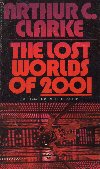 |
"The ultimate trip began with a story called THE SENTINEL, by Arthur C. Clarke. It took flight when Stanley
Kubrick asked Clarke to write a novel of space exploration upon which the acclaimed director would base a
movie. The result was one of the most extraordinary films of all time. Now for the first time the reader is taken on every stage of this great adventure. Here is the original story. Here are the different versions of 2001 as they evolved in the interplay between two brilliantly charged imaginations. And here is Clarke's own intimate account of the unique chemistry between author and director which created - 2001: A SPACE ODYSSEY." | ||||
| |||||
|
"Between the first and last decades of the Twentieth Century lay a gulf greater than the wildest imagination could have conceived. It was the gulf between gunpowder and nuclear bomb, between messages tapped in morse code and global television from the sky, between Queen Victoria, Empress of India, and Kwame Chaka, Supreme President of the African Federation. But above all, it was the gulf between the first hundred- foot flight at Kitty Hawk, and the first billion mile mission to the moons of Jupiter..."
The book is dedicated:
| |||||
| THE LOST WORLDS OF 2001 - LIST OF CONTENTS | |||||||
| - | Foreword | 1 | View of the Year 2000 | 2 | Son of Dr. Strangelove | 3 | The Sentinel |
| 4 | Christmas, Shepperton | 5 | Monoliths and Manuscripts | 6 | The Dawn of Man | 7 | First Encounter |
| 8 | Moon-Watcher | 9 | Gift from the Stars | 10 | Farewell to Earth | 11 | The Birth of HAL |
| 12 | Man and Robot | 13 | From the Ocean, from the Stars | 14 | With Open Hands | 15 | Universe |
| 16 | Ancestral Voices | 17 | The Question | 18 | Midnight, Washington | 19 | Mission to Jupiter |
| 20 | Flight Pay | 21 | Discovery | 22 | The Long Sleep | 23 | Runaway |
| 24 | First Man to Jupiter | 25 | The Smell of Death | 26 | Alone | 27 | Joveday |
| 28 | Jupiter V | 29 | Final Orbit | 30 | The Impossible Stars | 31 | Something Is Seriously Wrong with Space |
| 32 | Ball Game | 33 | Last Message | 34 | The Worlds of the Star Gate | 35 | Reunion |
| 36 | Abyss | 37 | Cosmopolis | 38 | Scrutiny | 39 | Skyrock |
| 40 | Oceana | 41 | Into the Night Land | 42 | Second Lesson | - | Epilogue |
![]()
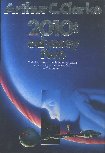 |
Carl Sagan made it on the front of the dust jacket of Arthur C. Clarke's not- quite- sequel to "2001: A Space
Odyssey", "2010: Odyssey Two". Sagan's endorsement is displayed right under the main title: "A daring romp
through the solar system and a worthy successor to 2001." The back of the jacket is given over to a
portrait photograph of Clarke. This book is slightly larger in format than the original. Embossed into the front
board cover is the same view of the Discovery as appears at the bottom of the jacket illustration.
|  | ||||
| ||||||
|
The front flap of the dust jacket includes the following.
When 2001: A Space Odyssey first shocked, amazed, and delighted millions in the late 1960s, the novel was quickly recognized as a classic. Since then, its fame has grown steadily among the multitudes who have read the novel or seen the film based on it. Yet, along with almost universal acclaim, a host of questions has grown more insistent through the years: Who or what transformed Dave Bowman into the Star Child? What purpose lay behind the transformation? What would become of the Star Child? What alien purpose lay behind the monoliths on the Moon and out in space? What could drive HAL, a stable, intelligent computer, to kill the crew? Was HAL really insane? What happened to HAL and the spaceship Discovery after Dave Bowman disappeared? Would there be a sequel? Now all those questions and many more have been answered. In this stunning sequel to his international best- seller, Clarke has written what will be truly one of the great books of the '80s. Cosmic in sweep, eloquent in its depiction of Man's place in the Universe, and filled with the romance of space, this novel is a monumental achievement. This is fiction in the grand tradition. Beside it, even 2001: A Space Odyssey is mere prologue! The back flap of the dust jacket contains biographical information about Clarke. The book has the following dedication.
Cover illustration is by Michael Whelan. Unlike its predecessor, 2010 comes complete with a contents list.
| ||||||
| 2010: ODYSSEY TWO - LIST OF CONTENTS | |||||||
| I LEONOV | |||||||
| 1 | Meeting at the Focus | 2 | The House of the Dolphins | 3 | SAL 9000 | 4 | Mission Profile |
| 5 | Leonov | - | - | - | - | - | - |
| II TSIEN | |||||||
| 6 | Awakening | 7 | Tsien | 8 | Transit of Jupiter | 9 | The Ice of the Grand Canal |
| 10 | A Cry from Europa | 11 | Ice and Vacuum | - | - | - | - |
| III DISCOVERY | |||||||
| 12 | Downhill Run | 13 | The Worlds of Galileo | 14 | Double Encounter | 15 | Escape from the Giant |
| 16 | Private Line | 17 | Boarding Party | 18 | Salvage | 19 | Operation WINDMILL |
| 20 | Guillotine | 21 | Resurrection | - | - | - | - |
| IV LAGRANGE | |||||||
| 22 | Big Brother | 23 | Rendezvous | 24 | Reconnaissance | 25 | The View from Lagrange |
| 26 | Probation | 27 | Interlude: True Confessions | 28 | Frustration | 29 | Emergence |
| V A CHILD OF THE STARS | |||||||
| 30 | Homecoming | 31 | Disneyville | 32 | Crystal Spring | 33 | Betty |
| 34 | Valediction | 35 | Rehabilitation | 36 | Fire in the Deep | 37 | Estrangement |
| 38 | Foamscape | 39 | In the Pod Bay | 40 | 'Daisy, Daisy...' | 41 | Graveyard Shift |
| VI DEVOURER OF WORLDS | |||||||
| 42 | The Ghost in the Machine | 43 | Thought Experiment | 44 | Vanishing Trick | 45 | Escape Manoeuvre |
| 46 | Countdown | 47 | Final Flyby | 48 | Over the Nightside | 49 | Devourer of Worlds |
| VII LUCIFER RISING | |||||||
| 50 | Farewell to Jupiter | 51 | The Great Game | 52 | Ignition | 53 | A Gift of Worlds |
| 54 | Between Suns | 55 | Lucifer Rising | - | - | - | - |
![]()
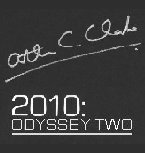 | If you are looking to own copies of these books, Arthur C. Clarke's signature is always a nice thing to have. | 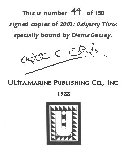 |
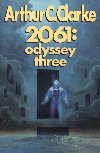 |
"2061: Odyssey Three" takes us into new territory, if for no other reason than that we have no visual
interpretation to help or hinder us. There is no film version of 2061, so we are free to draw whatever
conclusions
we like from Arthur C. Clarke's words alone. The back cover has the same picture of Arthur C. Clarke as was used for 2010.
| ||||||
| |||||||
|
The front cover flap description proclaims (with book titles capitalized (not), as shown): Only rarely does a novelist weave a tapestry so compelling that it captures the imagination of the entire world. But that is precisely what Arthur C. Clarke accomplished with 2001: a space odyssey. It is even more unusual that an author is able to complement so well- received an invention with an equally successful sequel. But Arthur C. Clarke's 2010: odyssey two enthralled a huge audience worldwide. Now, in 2061: odyssey three, Arthur C. Clarke revisits the most famous future ever imagined, as two expeditions into space are inextricably tangled by human necessity and the immutable laws of physics. And Heywood Floyd, survivor of two previous encounters with the mysterious monoliths, must once again confront Dave Bowman - or whatever Bowman has become - a newly independent HAL, and the power of an alien race that has decided Humanity is to play a part in the evolution of the galaxy whether it wishes to or not. Arthur C. Clarke's 2061: odyssey three is a truly masterful elaboration on one man's epic vision of the Universe. The book has the following dedication.
Cover illustration is by Michael Whelan. Here is the contents list for 2061.
| |||||||
| 2061: ODYSSEY THREE - LIST OF CONTENTS | |||||||
| I THE MAGIC MOUNTAIN | |||||||
| 1 | The Frozen Years | 2 | First Sight | 3 | Re-entry | 4 | Tycoon |
| 5 | Out of the Ice | 6 | The Greening of Ganymede | 7 | Transit | 8 | Starfleet |
| 9 | Mount Zeus | 10 | Ship of Fools | 11 | The Lie | 12 | Oom Paul |
| 13 | 'No-one told us to bring swimsuits...' | 14 | Search | - | - | - | - |
| II THE VALLEY OF BLACK SNOW | |||||||
| 15 | Rendezvous | 16 | Touchdown | 17 | The Valley of Black Snow | 18 | 'Old Faithful' |
| 19 | At the End of the Tunnel | 20 | Recall | - | - | - | - |
| III EUROPEAN ROULETTE | |||||||
| 21 | The Politics of Exile | 22 | Hazardous Cargo | 23 | Inferno | 24 | Shaka the Great |
| 25 | The Shrouded World | 26 | Night Watch | 27 | Rosie | 28 | Dialogue |
| 29 | Descent | 30 | Galaxy Down | 31 | The Sea of Galilee | - | - |
| IV AT THE WATER HOLE | |||||||
| 32 | Diversion | 33 | Pit Stop | 34 | Car Wash | 35 | Adrift |
| 36 | The Alien Shore | - | - | - | - | - | - |
| V THROUGH THE ASTEROIDS | |||||||
| 37 | Star | 38 | Icebergs of Space | 39 | The Captain's Table | 40 | Monsters from Earth |
| 41 | Memoirs of a Centenarian | 42 | Minilith | - | - | - | - |
| VI HAVEN | |||||||
| 43 | Salvage | 44 | Endurance | 45 | Mission | 46 | Shuttle |
| 47 | Shards | 48 | Lucy | - | - | - | - |
| VII THE GREAT WALL | |||||||
| 49 | Shrine | 50 | Open City | 51 | Phantom | 52 | On the Couch |
| 53 | Pressure Cooker | 54 | Reunion | 55 | Magma | 56 | Perturbation Theory |
| 57 | Interlude on Ganymede | - | - | - | - | - | - |
| VIII THE KINGDOM OF SULPHUR | |||||||
| 58 | Fire and Ice | 59 | Trinity | 60 | Midnight in the Plaza | - | - |
![]()
 |
"In the year the computer Hal was created, Arthur C. Clarke brings the Odyssey to the conclusion millions have
been awaiting." So commences the tale that brings to a close the Space Odyssey saga. As if Clarke doesn't have something up his sleeve to greet the new millennium, which he has set his sights on. | |||
| ||||
|
The front flap of the dust jacket includes the following.
Arthur C. Clarke, the greatest prophet of the space age, at last concludes the space odyssey he embarked upon in 1968 with both the book and film of 2001. He shared an Oscar nomination with Stanley Kubrick for the screenplay of the film, and later resolved some of its lingering enigmas in the sequels 2010 and 2061 - verifying Kubrick's comment, 'Arthur somehow manages to capture the hopeless yet admirable desire to know things that can really never be known'. Arthur C. Clarke's continuing and constant search for answers has brought us now the final episode in the greatest story ever written of humanity's destiny in space. With 3001: The Final Odyssey we experience once more the uncanny influence of the Monoliths and the limitless power of an alien technology. Frank Poole was last seen alive in the vicinity of the United States Spaceship Discovery en route to Jupiter's moons. The year was A.D. 2001 and the Series 9000 HAL computer on board Discovery had malfunctioned. Frank was Hal's first victim. Grappling frantically with the broken air hose of his spacesuit, Frank died in the blackness and vacuum of space. In A.D. 3001 his perfectly preserved body is retrieved by Captain Dimitri Chandler of the spacetug Goliath; medical and electro- optical technologies restore his life and then enhance it with a Braincap. Thus Frank becomes a telepathic, machine- assisted inhabitant of the first years of the fourth millennium, with a lot to learn. The alien Monoliths have been silent since the eruption of Jupiter into a sun in A.D. 2010. Their last message was a warning: ALL THESE WORLDS ARE YOURS EXCEPT EUROPA. ATTEMPT NO LANDINGS THERE. But Frank Poole is an exception to the aliens' interdict. Or so he hopes. Frank has unfinished business on Europa. And perhaps Dave Bowman, his long- lost colleague from the Discovery, is there, a thousand years older but not dead. And alien. Forever exploring the vastness of space and the mystery of life, Arthur Clarke has himself become the Odysseus of the space age. His imagination is the most celebrated in the world, yet he has written, 'The universe is such a strange and wonderful place that reality will always out- reach the wildest imagination'. The back flap of the dust jacket contains biographical information about Clarke. The book is dedicated:
Cover illustration is by Chris Moore. Here is the contents list for 3001.
| ||||
| 3001: THE FINAL ODYSSEY - LIST OF CONTENTS | |||||||
| PROLOGUE: The Firstborn | |||||||
| I - STAR CITY | |||||||
| 1 | Comet Cowboy | 2 | Awakening | 3 | Rehabilitation | 4 | A Room with a View |
| 5 | Education | 6 | Braincap | 7 | Debriefing | 8 | Return to Olduvai |
| 9 | Skyland | 10 | Homage to Icarus | 11 | Here be Dragons | 12 | Frustration |
| 13 | Stranger in a Strange Time | - | - | - | - | - | - |
| II - GOLIATH | |||||||
| 14 | A Farewell to Earth | 15 | Transit of Venus | 16 | The Captain's Table | - | - |
| III - THE WORLDS OF GALILEO | |||||||
| 17 | Ganymede | 18 | Grand Hotel | 19 | The Madness of Mankind | 20 | Apostate |
| 21 | Quarantine | 22 | Venture | - | - | - | - |
| IV - THE KINGDOM OF SULPHUR | |||||||
| 23 | Falcon | 24 | Escape | 25 | Fire in the Deep | 26 | Tsienville |
| 27 | Ice and Vacuum | 28 | The Little Dawn | 29 | The Ghosts in the Machine | 30 | Foamscape |
| 31 | Nursery | - | - | - | - | - | - |
| V TERMINATION | |||||||
| 32 | A Gentleman of Leisure | 33 | Contact | 34 | Judgement | 35 | Council of War |
| 36 | Chamber of Horrors | 37 | Operation Damocles | 38 | Pre-emptive Strike | 39 | Deicide |
| 40 | Midnight Pico | - | - | - | - | - | - |
| EPILOGUE | |||||||
![]()
When construction of this Web site first started, there was no indication that it might one day be possible to encompass the entire span of the Space Odyssey saga, from its beginnings in that short story to the closing words of "3001: The Final Odyssey". Yet the following words were written half a century apart.
| "The next time you see the full moon high in the
South, look carefully at its right- hand edge and let your eye travel upwards along the curve of the disc. Round
about 2 o'clock you will notice a small, dark oval; anyone with normal eyesight can find it quite easily. It is the
great walled plain, one of the finest on the Moon, known as the Mare Crisium - the Sea of Crises. Three
hundred
miles in diameter, and almost completely surrounded by a ring of magnificent mountains, it had never been
explored until we entered it in the late summer of 1996." From "Sentinel of Eternity". |
| "How ironic - that the human race had been
saved by the skilful deployment of its own insanities! What moral, Poole wondered, could one possibly draw
from that? He looked back at the beautiful blue Earth, huddling beneath its tattered blanket of clouds for protection against the cold of space. Up there, a few weeks from now, he hoped to cradle his first grandson in his arms. Whatever godlike powers and principalities lurked beyond the stars, Poole reminded himself, for ordinary humans only two things were important - Love and Death. His body had not yet aged a hundred years: he still had plenty of time for both." From "3001: The Final Odyssey". |
|
|
Click here to obtain copies of Arthur C. Clarke's books |
![]()
All original text: Copyright © 1997, 1998 by Underman